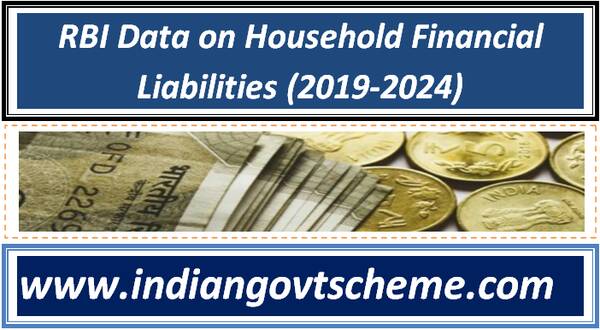RBI Data on Household Financial Liabilities (2019-2024)
GOVERNMENT OF INDIA
MINISTRY OF FINANCE
DEPARTMENT OF ECONOMIC AFFAIRS
LOK SABHA
UNSTARRED QUESTION No. 980
TO BE ANSWERED ON 10 FEBRUARY 2025
980. Ms Sayani Ghosh
HOUSEHOLD SAVINGS AND LIABILITIES
Will the Minister of FINANCE be pleased to state:
(a) the per capita household debt in the country during the last ten years, year-wise;
(b) the details of the households’ savings as a percentage of GDP during the last ten years, year- wise;
(c) whether it is a fact that household liabilities have increased during the last five years, if so, the details of the household liabilities as a percentage of GDP during the last ten years;

(d) whether the Government recognises ‘middle class’ as a category of consumers, if so, the details thereof; and
(e) whether the Government has taken note that the middle class is the worst affected consumer leading to a ‘shrinking middle class’ syndrome, if so, the steps taken by the Government in this regard?
ANSWER
MINISTER OF STATE IN THE MINISTRY OF FINANCE
(SHRI PANKAJ CHAUDHARY)
(a) As per Reserve Bank of India, the data on stock of household financial liabilities is available from March 2019. Accordingly, the data on per capita household financial liabilities from March 2019 to March 2024 are placed in Annexure A.
(b) As per National Account Statistics released by the Ministry of Statistics and Programme Implementation, the latest available data on household savings is for the year 2022-23. Accordingly, household savings as a percentage of GDP from 2014-15 to 2022-23 is placed in Annexure-B.
(c) As per Reserve Bank of India, the data on the stock of household financial liabilities is available from March 2019. Accordingly, the data on household financial liabilities as a percentage of GDP from March 2019 to March 2024 are placed in Annexure-C.
(d) & (e): The Government has proposed significant measures in the Union Budget 2025-26 to enhance the spending power of the middle class. In a major reform measure, the Union Budget has proposed that there will be no income tax payable upto income of ₹12 lakh under the new tax regime. The Budget has also proposed a change in slabs and rates of personal income tax across the board to benefit taxpayers. The new structure is expected to substantially reduce the taxes of the middle class and leave more money in their hands, boosting household consumption, savings and investment. The other measures of the Government to benefit the middle class include enhanced pension schemes, support for affordable housing, public health schemes, financial backing for entrepreneurs, and initiatives to promote sustainable infrastructure. The Government does not have any information on the ‘shrinking middle-class’ syndrome.
Annexure-A
|
As at end March |
Per capita household financial liabilities (in ₹) |
|
2019 |
46,898 |
|
2020 |
52,090 |
|
2021 |
57,306 |
|
2022 |
63,000 |
|
2023 |
73,887 |
|
2024 |
86,713 |
Source: The data on the stock of household financial liabilities are sourced from RBI. The population estimates are sourced from National Account Statistics, MoSPI for calculating the per capita household financial liabilities.
Annexure-B
|
Year |
Household savings (as per cent of GDP) |
|
2013-14 |
20.3 |
|
2014-15 |
19.6 |
|
2015-16 |
18.0 |
|
2016-17 |
18.1 |
|
2017-18 |
19.3 |
|
2018-19 |
20.3 |
| 2019-20 |
19.1 |
|
2020-21 |
22.7 |
|
2021-22 |
20.1 |
|
2022-23 |
18.4 |
Annexure-C
|
As at end March |
Household Financial Liabilities (as per cent of GDP) |
|
2019 |
32.9 |
|
2020 |
34.7 |
|
2021 |
39.1 |
|
2022 |
36.5 |
| 2023 |
37.9 |
|
2024 |
41.0 |
नोट :- हमारे वेबसाइट www.indiangovtscheme.com पर ऐसी जानकारी रोजाना आती रहती है, तो आप ऐसी ही सरकारी योजनाओं की जानकारी पाने के लिए हमारे वेबसाइट www.indiangovtscheme.com से जुड़े रहे।
